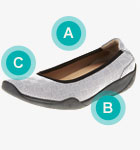Foot Ailments
Toes
- Blisters
- Bunions
- Corns and Calluses
- Hammertoes
- Ingrown Toenails
- Nail Remedies
- Overlapping Toes
- Thick Yellow Toenails
- Toe Pain Pinched Toes
Ball
Arch
Heel
Entire Foot
- Arthritis
- Athletes Foot
- Blisters
- Bromhidrosis
- Bursitis
- Charcot Foot
- Cold Feet
- Corns
- Diabetic Neuropathy
- Dry Skin
- Foot Odor
- Foot Perspiration
- Hot Feet
- Hyperhidrosis
- Itchy Feet
- Pronation
- Supination
- Swollen Feet Legs Edema
- Tarsal Tunnel Syndrome
- Tired Aching Feet
- Wide Feet
Leg Ailments
Entire Leg
- Arthritis
- Circulation
- DVT
- Economy Class Syndrome
- Swollen Feet Legs Edema
- Heaviness In Legs
- Leg Length Discrepancy
- Leg Pain
- Leg Veins
- Shin Splints
- Spider Veins
- Swollen Feet & Legs
- Varicose Veins
- Venous Insufficiency
- Wide Calves
Ankle
Knee
Back Ailments
Entire Back
Bunions
Learn more about diagnosis, treatment, and prevention.
Could I have a bunion?
A bunion affects these regions of your foot:
A.) Toes
B.) Ball of Foot
WHAT ARE THE CAUSES AND SYMPTOMS?

While the word “bunion” sounds rather simple, it’s the name of a quite serious and painful condition. You’ll notice a bunion as a bump jutting out on either the base or side of your big toe joint. This happens when your first toe bone pushes inward too much onto your second toe bone, disrupting the alignment of your first metatarsal bone (which is the bone in your foot that’s attached to your first toe bone). When unaligned, your toe bone separates from your metatarsal bone and creates a bump where the bone juts out.
Think you might have a bunion?
TAKE THIS SELF-ASSESSMENT
Self- Assessment Quiz
- Have a bump on it?
- Feel a dull ache with occasional shooting pains (especially after extended periods of activity)?
- Feel pain when you move it?
If you answered “yes” to any of these questions, you show some key symptoms of having a bunion.
TAKE THE NEXT QUICK QUIZ.
Think you might have a bunion?
TAKE THIS SELF-ASSESSMENT
Self- Assessment Quiz
- A reddening or inflammation of the bump
- Blisters and/or callouses in and around your first and second toes
- Pain when walking or wearing restrictive shoes (such as high heels)
- Your second toe overlapping your first toe
- Ingrown toenails
- Sores between your toes
- Arthritis in your big toe
If you might have a bunion, confirm your condition with a foot and ankle specialist (podatrist).
Are there any serious concerns with Bunions?
As a progressive deformity, bunions start out small but grow worse over time. Because bunions are painful, you’ll walk differently to compensate. That’s why bunions can also affect the ball of your foot and the area under your big toe. By placing your weight onto these other areas of your foot, you risk additional foot pain, foot health conditions, and even stress fractures as a result of untreated bunions.
How do I treat and prevent Bunions?
Non-surgical treatments won’t correct your bone deformity, but you can alleviate your bunion pain and perhaps put off surgery for a while. The most important non-surgical treatment for a bunion is simple: Wear roomy and comfortable shoes.

- Stretchable, breathable qualities
(like a good slip-on shoe) - Good arch support
- A wide toe box
- Padding and toe spacers. Cushioning (such as silicone pads) help alleviate pressure around your toe joints, reduce friction, and protect the tender area around your bunion.
- Shields and splints. These treatments help alleviate pressure on your bunion, properly adjust the positioning of your toes, and provide extra room to decrease irritation.
- Medication. Pain relievers such as naproxen, ibuprofen, or even a cortisone injection may help with bunion pain and swelling.
- Icing and cold therapy. Ice can help reduce bunion-related swelling and alleviate pain.
- Modifying your activities. Reduce any heavy exercising, walking, or standing if you normally put pressure on your feet for long periods of time every day.
What if non-surgical treatments do not work?

Since bunion surgery will have a serious effect on your feet for up to 6-12 months, only consider surgical treatment if:
- Your bunion pain prevents you from performing your routine daily activities.
- Non-surgical treatments have failed to alleviate your bunion pain and swelling.
Bunion surgery may involve:
- A simple bone shaving if the bunion is small, with minimal pain.
- Cutting the foot bone and then shaving the bump. This kind of bunion surgery is more common, especially for severe bunions that cause you a lot of pain. The surgeon will cut your foot bone, adjust it back to the correct position, and secure it with screws, pins, or wires. Then the surgeon will shave the bump.
Bunion surgery recovery time may take up to 6-12 months, with the most intense recovery time occurring up to 3 months after surgery. You will experience some pain, wear a cast or splint, and undergo physical therapy. Your podiatrist will also likely recommend an ongoing application of the non-surgical therapies listed above to help prevent future bunions.

